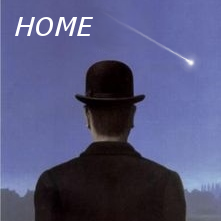All Hicksons so far
In this topic I am leaving the traditional “eyepiece view” and provide a crop of the original Hickson sketches that I have done so far. Therefore, more attention to detail can be achieved. Additionally, there is an inverted and enhanced inset with remarks about the Hickson galaxies seen. In the text you will often find the abbreviations AV (averted vision) and DV (direct vision).
All sketches have been corrected to show North ↑ up and West → right.
I will try to sketch each Hickson galaxy group with my 20″ scope which is based on La Palma. Some Hickson groups were already touched in my project to sketch all Arp galaxies with a 16″ and I have not observed those again where I saw no additional details in the 20″.
More info about the Hickson Compact Group can be found on Wikipedia. Additionally, more info about observing the Hickson galaxies can be found in Alvin Huye’s observing guide and Reiner Vogel’s website. The complete Hickson catalog can be reviewed and downloaded to Excel or Skysafari from Deepskylog, the tool that I use to prepare and log most of my observations.
Good luck and above all: Have Fun!
Hickson 16
A – NGC 835: mag 12.1, size 1.3′ x 1.1′
B – NGC 833: mag 12.7, size 1.5′ x 1.7′
C – NGC 838: mag 13.0, size 1.2′ x 0.9′
D – NGC 839: mag 13.1, size 1.4′ x 0.7′
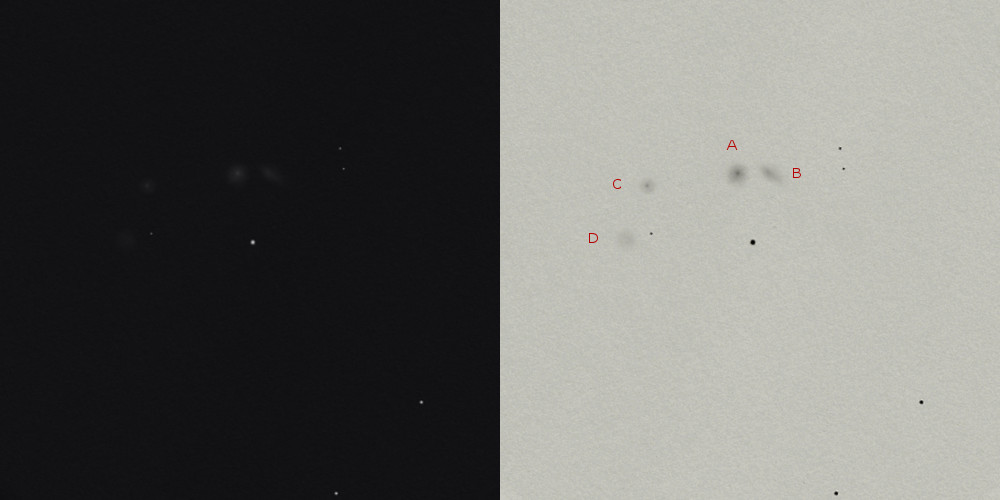
All four components are seen, but not the streamers. NGC 833 shows a bit of an ellipse and is not noticeably brighter in the center. NGC 835 is the most distinct member one of the group, it’s round with a bright core. NGC 838 is smaller en dimmer, but the stellar core is clearly visible. NGC 839 is a small and round glow without any central brightening, with AV it swells a bit more.
Hickson 38
A – PGC 26831: mag 16.0, size 0.9′ x 0.2′
B – PGC 26842: mag 15.3, size 1.0′ x 0.6′
C – PGC 26844: mag 16.0, size 0.4′ x 0.2′
D – PGC 26830: mag 17.1, size 0.3′ x 0.3′
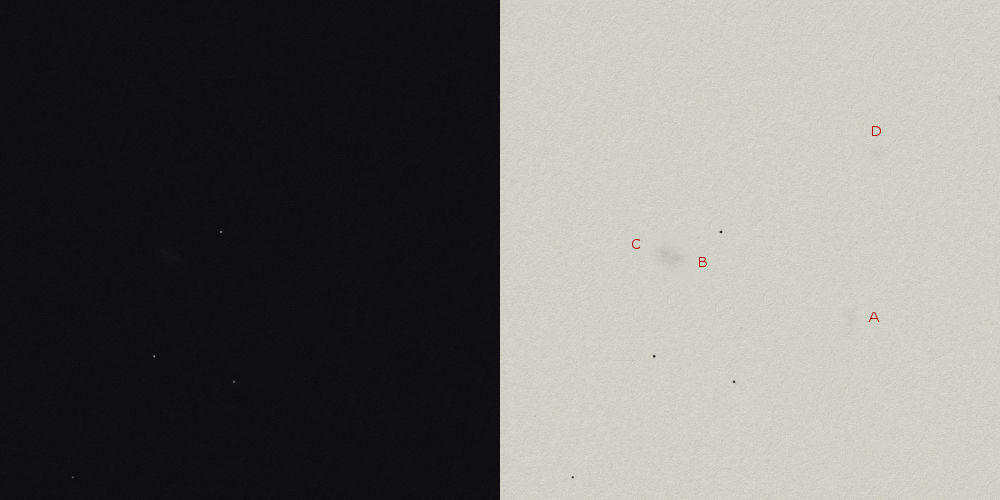
The two galaxies of UGC 5044 (PGC 26842 and PGC 26844) are seen as one and not (truly) separated, only suspected with AV. These are the brightest two galaxies in the field. PGC 26831 can be seen off and on with AV and is clearly not round but more needle shaped. PGC 26830 is extremely difficult and could only be confirmed after a long and focussed observation.
Hickson 40
A – PGC 27509: mag 13.8, size 1.3′ x 1.0′
B – PGC 27513: mag 15.0, size 1.1′ x 0.7′
C – PGC 27508: mag 15.7, size 1.1′ x 0.3′
D – PGC 27516: mag 15.1, size 0.9′ x 0.4′
E – PGC 27515: mag 17.4, size 0.7′ x 0.3′ (not seen)
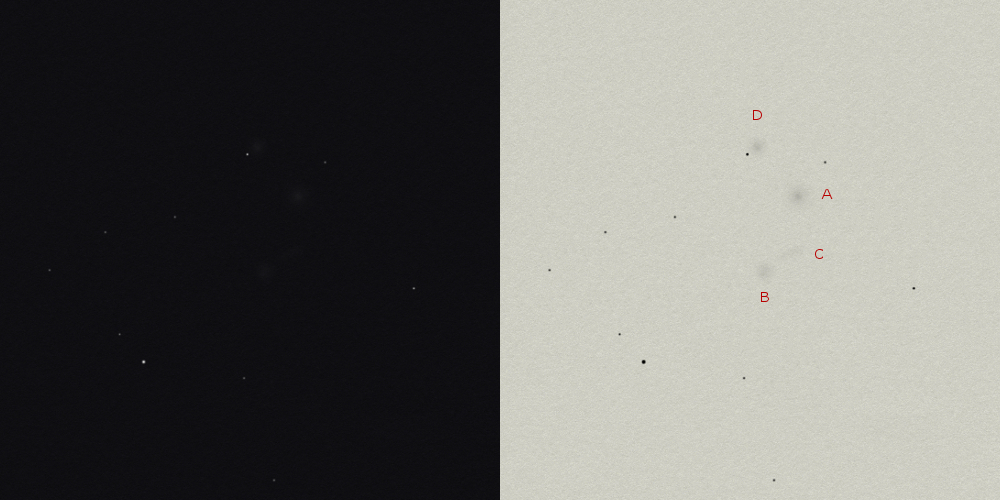
Very nice group of PCG galaxies where 4 of 5 members could be seen. PGC 27509 is the brightest and largest and could be seen with DV with some central brightening. PGC 27513 is only seen with AV as a round and smooth dot. PGC 27508 took some effort, but was seen as elongated with AV and PGC 27516 is positioned right next to a star and could just be seen with DV as small and roundish. Unfortunately, PGC 27515 was out of reach.
Hickson 44
A – NGC 3190: mag 12.1, size 4.4′ x 1.5
B – NGC 3193: mag 11.8, size 3.0′ x 2.7′
C – NGC 3185: mag 12.2, size 2.1′ x 1.4′
D – NGC 3187: mag 13.9, size 3.0′ x 1.3′

Famous group of four galaxies in the neck of Leo. NGC 3193 is very bright, round and with a relatively large core area close to a brighter star. NGC 3190 is stretched and the slightly oval centre is a bit brighter. It is about as eyecatching as NGC 3193. That can’t be said of NGC 3187, which is only visible with AV. It has a thick needle shape too, pointing in exactly the same direction as NGC 3190. Lastly, at some distance NGC 3185 is seen as an almost round stain of nebulosity with a hardly brighter core. It can be seen with direct vision. The four galaxies reside in a nice starfield with big differences in magnitude.
Hickson 55
A – PGC 35575: mag 15.9, size 0.4′
B – PGC 35572: mag 16.4, size 0.3′ x 0.2′
C – PGC 35573: mag 17.0, size 0.6′ x 0.4′ (not seen)
D – PGC 35574: mag 17.2, size 0.3′ x 0.2′ (not seen)
E – PGC 35576: mag 18.5, size 0.2′ (not seen)
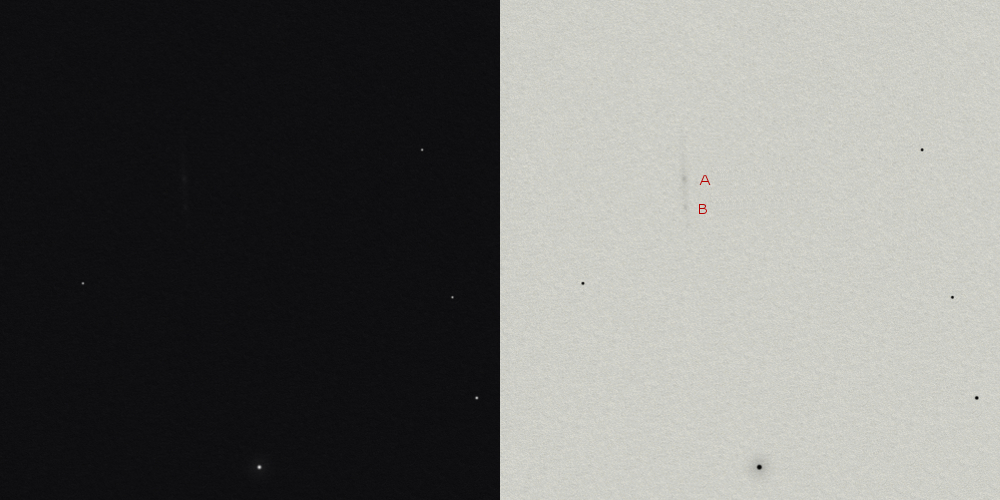
Very challenging observation. First impression is a long, but small and dim line. The first galaxy that can be seen individually is the one in the center (PGC 35575) and after a while a second one at the southern tip is suspected (PGC 35572).
Hickson 57 – Copeland’s Septet
A – NGC 3753: mag 14.5, size 1.7′ x 0.5′
B – NGC 3746: mag 15.0, size 1.1′ x 0.5′
C – NGC 3750: mag 14.9, size 0.8′ x 0.7′
D – NGC 3754: mag 15.0, size 0.4′ x 0.3′
E – NGC 3748: mag 15.8, size 0.7′ x 0.4′
F – NGC 3751: mag 15.2, size 0.5′ x 0.2′
G – NGC 3745: mag 16.2, size 0.4′ x 0.2′
H – PGC 36010: mag 17.4, size 0.3′ x 0.2′ (not seen)
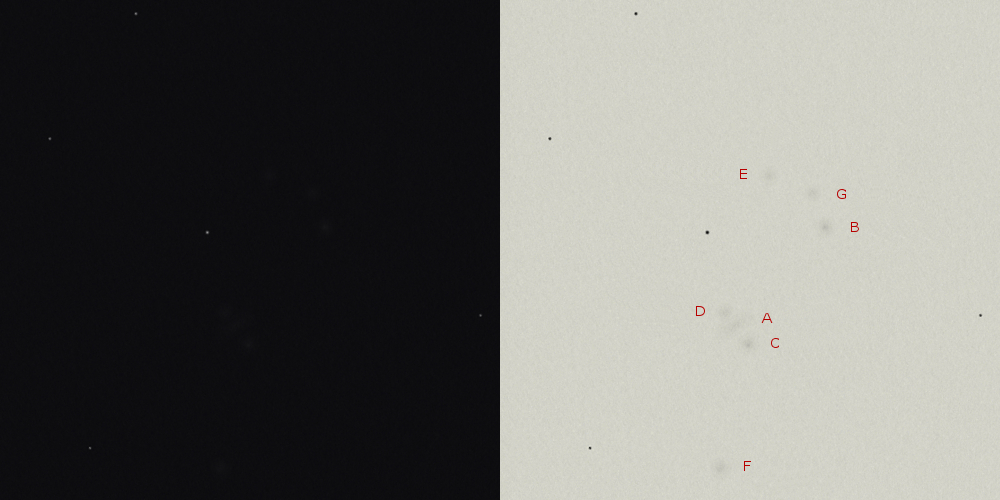
A beautiful group, but very dim and high magnification is required to see the galaxies apart from each other.
NGC 3753; largest and the only one seen with an oblong shape
NGC 3746; pretty bright and small
NGC 3750; pretty bright, round and small, close to NGC 3753
NGC 3754; round fuzz, very close to NGC 3753, but separation can be seen
NGC 3748; only with AV as a small and round fuzz
NGC 3751; only with AV and very dim, small and round
NGC 3745; dimmest, only seen with AV most of the time
PGC 36010 was not seen
Hickson 72
A – PGC 52844: mag 16.1, size 0.5′ x 0.1′
B – PCG 52851: mag 16.1, size 0.5′ x 0.2′
C – MCG+3-38-22: mag 16.1, size 0.6′ x 0.2′
D – PGC 52848: mag 16.0, size 0.2′
E – PCG 52850: mag 18.6, size 0.2′ (not seen)
F – PCG 52847: mag 18.6, size 0.2′ (not seen)
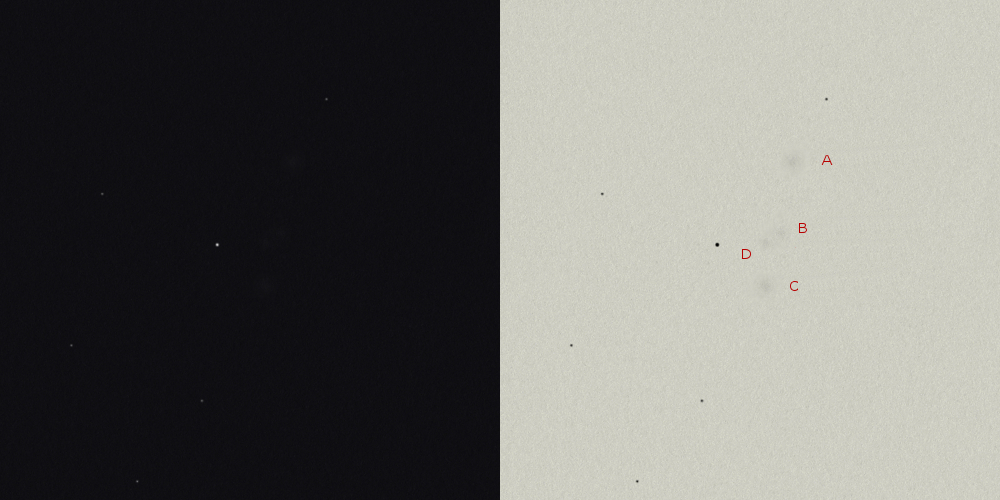
Group of four galaxies in a line, seen individually. All galaxies have the same brightness, although the two in the center are smaller and nearly touching. With AV they can be seen separate in a shared folder of nebulosity. Only four of six galaxies in total could be seen, but it takes effort.
Hickson 73
A – NGC 5829: mag 13.6, size 1.8′ x 1.5′
B – IC 4526: mag 15.4, size 0.4′ x 0.3′
C – PGC 53720: mag 15.8, size 0.3′ x 0.2′
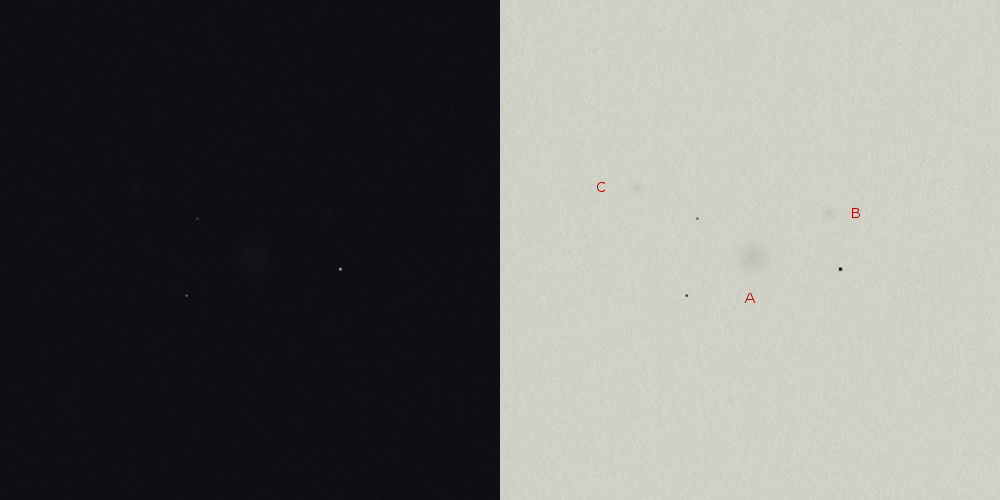
NGC 5829 is immediately seen as a round face-on with no central brightening. Two very tine dots can be seen blinking up sometimes: IC 4526 a little easier than PGC 53720. D and E were not seen
Hickson 92 – Stephan’s Quintet
A – NGC 7320: mag 13.2, size 2.3′ x 1.1′
B – NGC 7318B: mag 13.9, size 1.4′ x 0.9′
C – NGC 7319: mag 13.1, size 1.5′ x 1.1′
D – NGC 7318A: mag 14.3, size 0.8′ x 0.6′
E – NGC 7317: mag 13.6, size 0.8′ x 0.7′
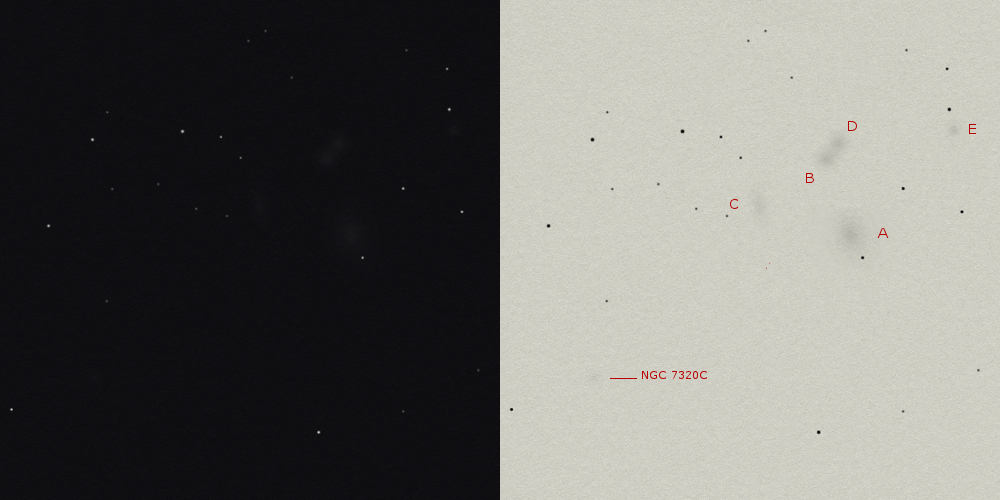
Very satisfying group of galaxies that can be seen without much effort. It does take a high magnification though to split NGC 7318. NGC 7320 is the largest and brightest of the group, while NGC 7317 is very small and looks like a fluffy star. NGC 7319 is also dim, but the length and direction of the galaxy can be seen. NGC 7320C, which is not a member of either the Arp or the Hickson group, is very difficult to see and can only be seen blinking from time to time and then only under transparent sky conditions.
Hickson 95
A – NGC 7609: mag 14.7, size 0.8′ x 0.5′
B – PGC 71080: mag 16.0, size 0.7′ x 0.2′
C – PGC 71074: mag 17.2, size 0.7′ x 0.2′ (not seen)
D – PGC 71077: mag 16.2, size 1.0′ x 0.3′
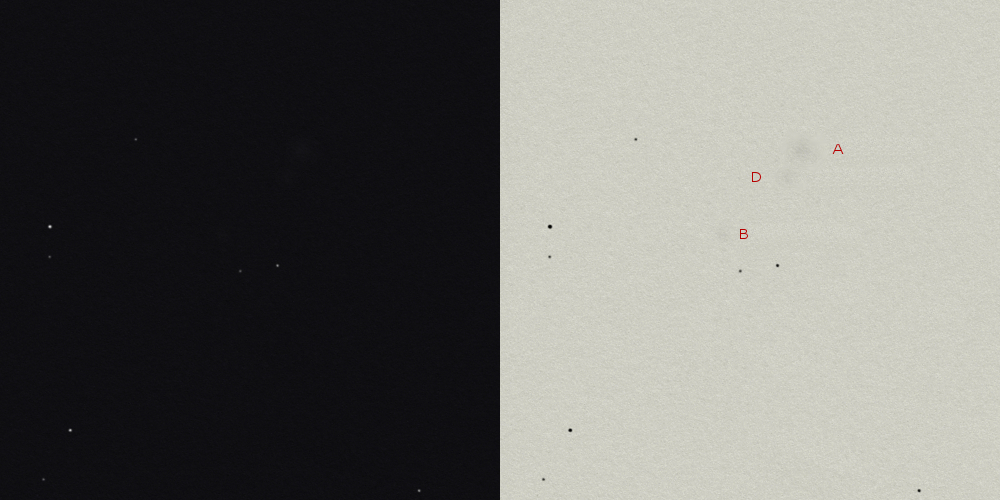
Very dim group of galaxies. NGC 7609 can be seen with ease, but it takes the 5mm to split this galaxy with PGC 71080, which in its turn can only be seen blinking now and then with AV. At a short distance, PGC 71077 can be found, but it it’s even smaller and harder to see. PGC 71074, the fourth (C) member of the group could not be seen.
Hickson 96
A – NGC 7674: mag 13.9, size 1.1′ x 1.0′
B – NGC 7675: mag 14.8, size 0.6′ x 0.5′
C – NGC 7674A: mag 16.1, size 0.4′ x 0.3′
D – PGC 71507: mag 17.1, size 0.2′ x 0.1′ (not seen)
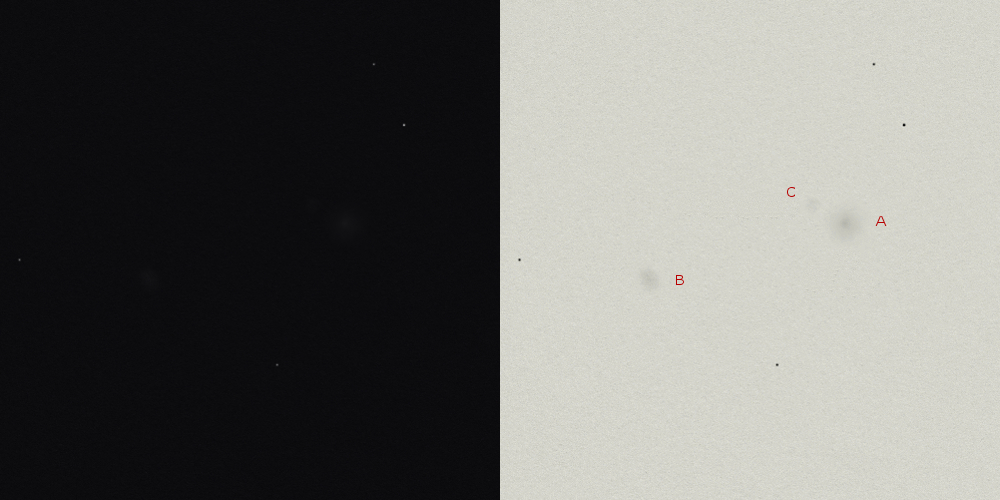
Compact group of four galaxies, of which three are visible. NGC 7674 is the largest and brightest member, brightening towards the core en with a large surrounding glow. No spiral structure is visible. A very small and dim galaxy is just next to it: NGC 7674A. This one is only seen with AV, but still set loose from its neighbour. NGC 7675 can just be seen with direct vision as a small oval, the PA can be seen. There is no brightening towards the core. PGC 71507 is out of reach for now, but should perhaps be possible from an even darker location.
Hickson 98
A – NGC 7783: mag 14.0; size 1.3′ x 0.7′
B – NGC 7783B: mag 15.0; size 0.4′ x 0.3′
C – PGC 72810: mag 15.4; size 0.3′ x 0.3′
D – NGC 7783C: mag 16.2; size 0.3′ x 0.2′ (not seen)
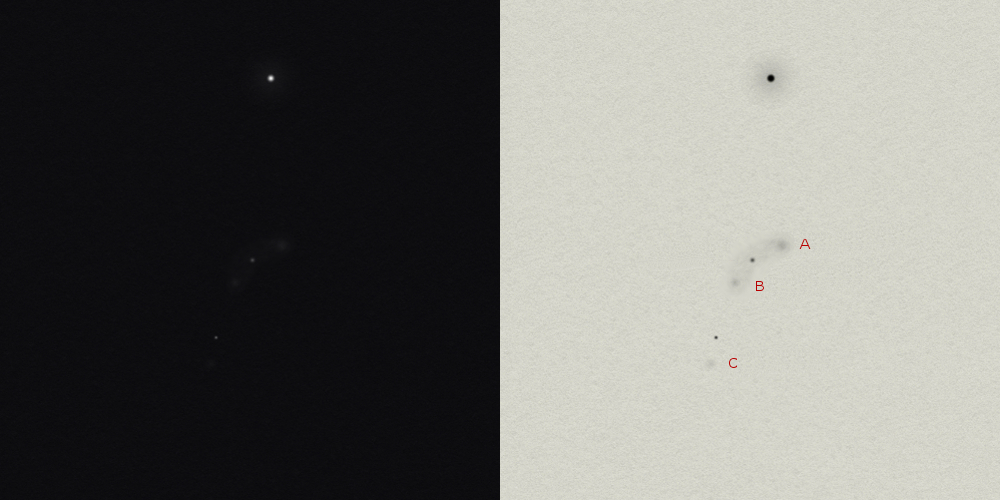
NGC 7783 is the brightest member, seen as a clear knot at the N side of a curved, nebulous glow. At the S side NGC 7783B is seen as a somewhat dimmer and smaller knot. Between these two galaxies a dim m14.9 is visible. Further S and fully separated from the above mentioned nebulosity, a dim star and NGC 7783C are seen loose from each other. The galaxy is very hard to discern with averted vision. A bright m10 star nearby disturbs a bit and (partially) prevents the final member NGC 7783D from being seen, but perhaps it’s just too dim.
Hickson ?
